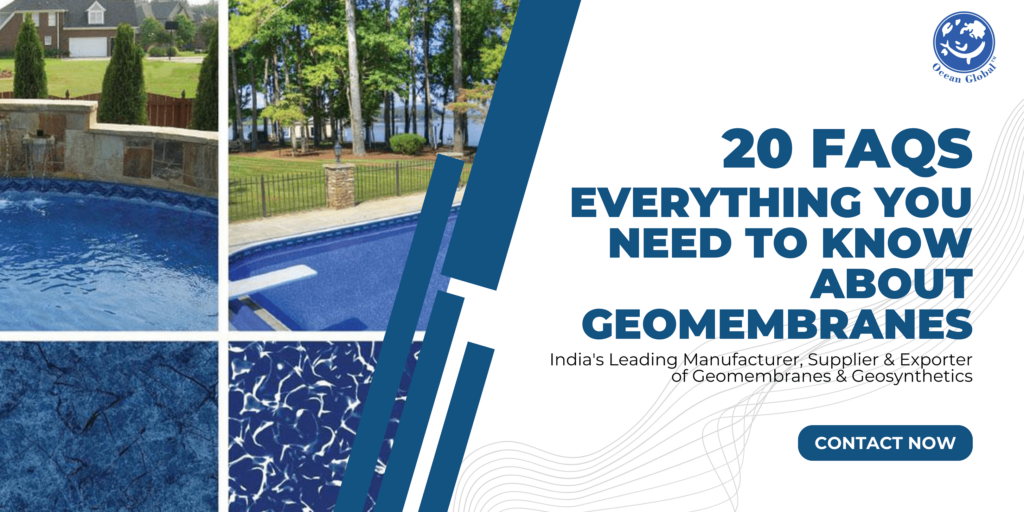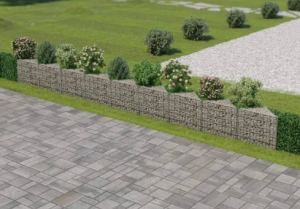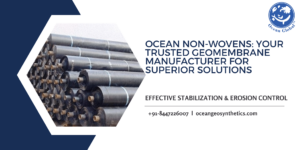20 FAQs About Geomembranes: Everything You Need to Know About Geomembranes

Geomembranes are a versatile material with a wide range of applications. This blog post answers 20 of the most commonly asked questions about geomembranes, covering topics such as what they are, how they are used, and their benefits and limitations. Whether you are an engineer, contractor, or student, this blog post is a valuable resource for learning more about geomembranes.
1. What is a geomembrane?
A geomembrane is a continuous sheet of high-density polyethylene (HDPE), polyvinyl chloride (PVC), or other synthetic material that is used to control water, air, or other fluids. Geomembranes are typically used in civil engineering projects, such as landfills, dams, and wastewater treatment plants.
2. What are the different types of geomembranes?
There are two main types of geomembranes: HDPE and PVC. HDPE geomembranes are the most common type and are made from high-density polyethylene, a strong and durable material. PVC geomembranes are less common but are more resistant to chemicals and UV radiation.
3. What are the benefits of using geomembranes?
Geomembranes offer a number of benefits, including:
- They are highly effective at controlling water and other fluids.
- They are durable and can withstand harsh environmental conditions.
- They are relatively inexpensive to install and maintain.
- They can be used in a variety of applications.
4. What are the limitations of using geomembranes?
Geomembranes have a few limitations, including:
- They can be susceptible to punctures and tears.
- They can be difficult to repair.
- They can be affected by UV radiation and chemicals.
5. How are geomembranes installed?
Geomembranes are typically installed by a contractor who specializes in geomembrane installation. The installation process will vary depending on the specific application, but typically involves the following steps:
- Preparation of the site. The site must be prepared by removing any debris or vegetation.
- Excavation. The area where the geomembrane will be installed must be excavated to the proper depth.
- Placement of the geomembrane. The geomembrane is placed in the excavated area and secured in place with sand, gravel, or other materials.
- Seams. The seams between geomembrane sheets must be properly sealed to prevent leaks.
- Testing. The geomembrane must be tested to ensure that it is properly installed and that there are no leaks.
6. What are the common applications for geomembranes?
Geomembranes are used in a variety of applications, including:
- Landfills
- Dams
- Wastewater treatment plants
- Oil and gas production
- Agriculture
- Construction
- Mining
- Transportation
7. How long do geomembranes last?
The lifespan of a geomembrane will vary depending on the specific application and the materials used. However, properly installed geomembranes can last for many years.
8. How much do geomembranes cost?
The cost of geomembranes will vary depending on the size, type, and thickness of the material. However, geomembranes are typically a cost-effective solution for a variety of applications.
9. What are the safety considerations for working with geomembranes?
Geomembranes can be hazardous if not handled properly. It is important to be aware of the following safety considerations when working with geomembranes:
- Always wear personal protective equipment (PPE) when working with geomembranes.
- Be aware of the potential for punctures and tears.
- Do not use sharp objects near geomembranes.
- Dispose of geomembranes properly.
10. Where can I learn more about geomembranes?
There are a number of resources available to learn more about geomembranes, including:
- The American Society of Civil Engineers (ASCE)
- The Geosynthetics Association
- The Association of Geomembrane Producers
- The International Geomembranes Society
11. What are the different properties of geomembranes?
Geomembranes have a number of properties that make them well-suited for a variety of applications. These properties include:
- High tensile strength
- Low permeability
- Chemical resistance
- UV resistance
- Durability
12. What are the different types of geomembranes?
There are a number of different types of geomembranes available, each with its own unique properties and applications. The most common types of geomembranes include:
- HDPE geomembranes
- PVC geomembranes
- LLDPE geomembranes
- LDPE geomembranes
- CSPE geomembranes
13. What are the different methods for installing geomembranes?
The method for installing a geomembrane will vary depending on the specific application and the materials used. However, the most common methods for installing geomembranes include:
- Hot-air welding
- Solvent welding
- Mechanical fastening
- Thermal fusion
14. What are the different types of geomembrane seams?
There are a number of different types of geomembrane seams, each with its own unique properties and applications. The most common types of geomembrane seams include:
- Butt welds
- Lap welds
- Flange welds
- Tongue-and-groove welds
15. How are geomembranes tested?
Geomembranes are typically tested to ensure that they meet the required standards for strength, permeability, chemical resistance, UV resistance, and durability. The most common tests for geomembranes include:
- Tensile strength test
- Water permeability test
- Chemical resistance test
- UV resistance test
- Durability test
16. What are the common failures of geomembranes?
Geomembranes can fail for a number of reasons, including:
- Punctures
- Tears
- Degradation due to UV radiation
- Degradation due to chemicals
- Poor installation
17. How can geomembranes be repaired?
Geomembranes can be repaired in a number of ways, depending on the severity of the damage. The most common methods for repairing geomembranes include:
- Hot-air welding
- Solvent welding
- Mechanical fastening
- Thermal fusion
18. What are the environmental benefits of using geomembranes?
Geomembranes can offer a number of environmental benefits, including:
- Reduced water pollution
- Reduced air pollution
- Reduced land use
- Reduced energy consumption
19. What are the economic benefits of using geomembranes?
Geomembranes can offer a number of economic benefits, including:
- Reduced construction costs
- Reduced maintenance costs
- Increased asset life
- Increased productivity
20. What are the future trends for geomembranes?
The future trends for geomembranes are expected to include:
- Increased use of geomembranes in new applications
- Development of new geomembrane materials with improved properties
- Development of new methods for installing and repairing geomembranes
Contact us to learn more about geomembranes from India’s leading Geomembrane Manufacturers.



